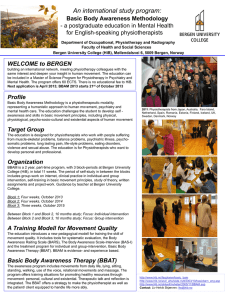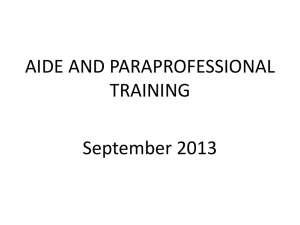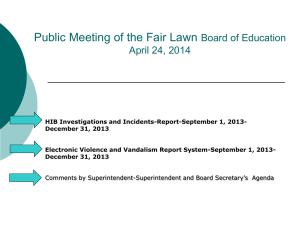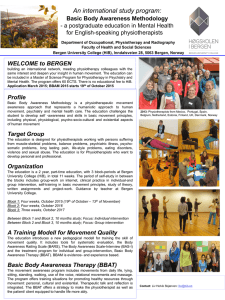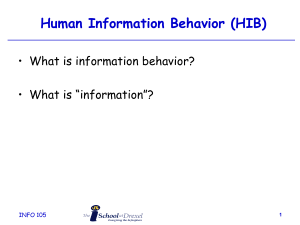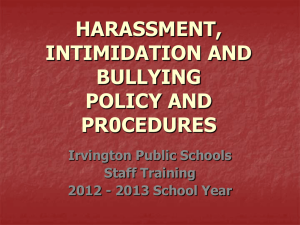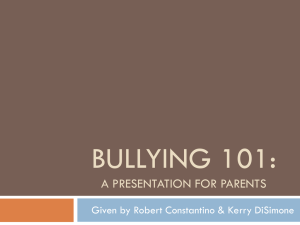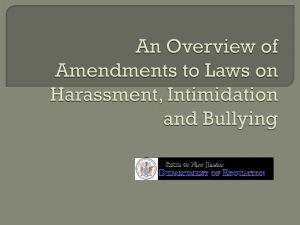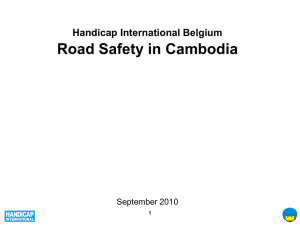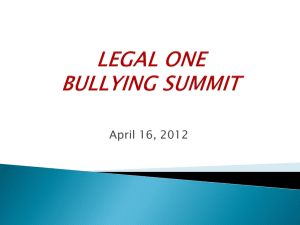HIB Presentation Security 2014-15
advertisement
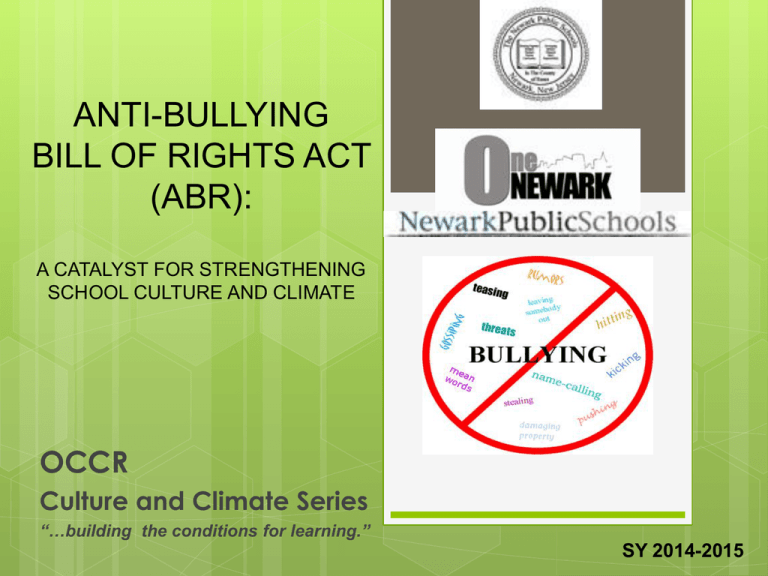
ANTI-BULLYING BILL OF RIGHTS ACT (ABR): A CATALYST FOR STRENGTHENING SCHOOL CULTURE AND CLIMATE OCCR Culture and Climate Series “…building the conditions for learning.” SY 2014-2015 Culture and Climate Series “…..building the conditions for learning.” Anti-Bullying PSA https://www.youtube.com/watch?v=DFf GQy9fg4&feature=player_detailpage#t=9 OCCR Culture and Climate Series “…building the conditions for learning.” Session Goal TO PROVIDE SCHOOL STAFF WITH STRATEGIES AND PRACTICES FOR IMPROVING SCHOOL SAFETY, ENHANCING SCHOOL CULTURE AND CRAFTING A SUPPORTIVE SCHOOL CLIMATE WHERE ALL MEMBERS ARE SAFE FROM HARRASSMENT, INTIMIDATION, AND BULLYING (HIB). OCCR Culture and Climate Series “…building the conditions for learning.” LEARNING OBJECTIVES 1. Understand NPS prevention and intervention requirements within the ABR. 2. Understand best practices in HIB intervention for: NPS Reporting Protocols Addressing the characteristics and needs of bullies and victims. Remediating HIB behavior through use of Restorative Conferences 3. Understand best practices in HIB prevention for: Developing positive school climate and culture. The effective management and coordination of prevention programs. Data-driven decision making and action planning. OCCR Culture and Climate Series “…building the conditions for learning.” ABR Requirements: Prevention HIB Training BOE members School Leaders HIB Policy Training Full-and part- time staff New Employees Volunteers who have significant contact with students Persons contracted to provide services to students The training must include instruction on preventing bullying on the basis of the protected categories and other distinguishing characteristics. OCCR Culture and Climate Series “…building the conditions for learning.” ABR Requirements: Prevention, con’t. Professional Development HIB Each Teacher and educational services professional must complete at least two hours of instruction on HIB prevention in each professional development period. Suicide Each teacher and educational services professional also must complete two hours of instruction in suicide prevention. The training must include information on the relationship between risk of suicide and incidents of HIB and information on reducing the risk of suicide in students who are members of communities identified as having members at high risk of suicide. OCCR Culture and Climate Series “…building the conditions for learning.” ABR Requirements: Prevention, con’t. Appointments District Anti-bullying Coordinator (ABC) School Anti-bullying Specialist (ABS) Organizational Requirements School Safety Team (SST) in each school building OCCR Culture and Climate Series “…building the conditions for learning.” District Anti-Bullying Coordinator (ABC) ABC Responsibilities Coordinate and strengthen the school district’s HIB policies to HIB of students. Prevention and Intervention - training and policy enforcement to prevent, identify and address HIB acts in the district. Provide data, in collaboration with the CSA, to the NJDOE regarding HIB of students. OCCR Culture and Climate Series “…building the conditions for learning.” School Anti-Bullying Specialist (ABS) ABS Responsibilities Prevention Chair the School Safety Team (SST) Act as the primary school official responsible for preventing, identifying and addressing incidents of HIB in the school. Provide input to the BOE on the annual re-evaluation, reassessment and review of the HIB policy. Intervention Act as the primary school official responsible for preventing, identifying and addressing incidents of HIB in the school. Lead, in coordination with the principal, the investigation of reported HIB incidents. Assist the principal in determining the responses to be implemented that have been established by the BOE. Provide input for a BOE hearing, in executive session, on reported HIB incidents, recommendations for discipline or services and any programs instituted to reduce these incidents. OCCR Culture and Climate Series “…building the conditions for learning.” Development of a School Safety Team (SST) A SST is required in each school. The SST must consist of the principal or designee, a teacher in the school, an ABS, a parent of a student in the school, and other members determined by the principal. The SST is required to meet minimally twice per academic year. The team is responsible to: Develop, foster and maintain a positive school climate by focusing on the ongoing, systemic practices in the school and addressing climate issues, such as HIB. Review and strengthen the school climate and the policies of the school in order to prevent HIB of students. Educate the community, including students, teachers, administrators and parents to prevent and address HIB of students. Participate in the training required under the ABR and other training requested by principal, including professional development on effective practices for developing safe and supportive school climates. OCCR Culture and Climate Series “…building the conditions for learning.” The School Safety Team (SST), cont. Receive complaints of HIB of students that have been reported to the principal.* Receive copies of investigative reports of HIB of students.* Identify and address patterns of HIB of students in the school (when student’s personally identifiable information is redacted). Collaborate with the ABC in the collection of district-wide data and in the development of district HIB policies. Execute other HIB-related duties as requested by the principal or the ABC. *Parents serving on the SST are not permitted to participate in activities that may compromise the confidentiality of a student. OCCR Culture and Climate Series “…building the conditions for learning.” ABR Definition of HIB HIB means any gesture, any written, verbal or physical act, or any electronic communication, whether it be a single incident or series of incidents, that: is reasonably perceived as being motivated by any actual or perceived characteristic, such as race, color, religion, ancestry, national origin, gender, sexual orientation, gender identity and expression, or a mental, physical or sensory disability, or by any other distinguishing characteristic, and that takes place on school property, at any schoolsponsored function [or], on a school bus, off school grounds as provided for in section 16 of P.L. 2010, c 122, and substantially disrupts or interferes with the orderly operation of the school or the rights of other students, and that: OCCR Culture and Climate Series “…building the conditions for learning.” ABR Definition of HIB con’t. A reasonable person should know, under the circumstances, will have the effect of physically or emotionally harming a student or damaging the student's property, or placing a student in reasonable fear of physical or emotional harm to his person or damage to his property; [or] Has the effect of insulting or demeaning any student or group of students [in such a way as to cause substantial disruption in, or substantial interference with, the orderly operation of the school]; or Creates a hostile educational environment for the student by interfering with a student’s education or by severely or pervasively causing physical or emotional harm to the student. OCCR Culture and Climate Series “…building the conditions for learning.” ABR Definition of HIB con’t. It is important to note that the amended law supplements the provisions under the previous HIB statute, with exception of the following changes: HIB Off School Grounds – The HIB definition and the HIB policies and procedures must address incidents that occur off school grounds when they substantially disrupt or interfere with the orderly operation of the school or the rights of other students. All Acts of HIB - The HIB definition clarifies that the HIB policies and procedures apply to a single incident or a series of incidents. OCCR Culture and Climate Series “…building the conditions for learning.” Intervention NPS Reporting Trends and Protocols Addressing the characteristics and needs of bullies and victims. Remediating HIB behavior using a range of responses. Developing and monitoring a behavior support plan. OCCR Culture and Climate Series “…building the conditions for learning.” Scenario “A” At least once a week, Beto waits for Juan after school and physically hurts him. Juan has never figured out why Beto has a problem with him and always hurts him. Juan feels that he cannot go to any teacher because Beto is a good student and all the teachers love him. Is this bullying? OCCR Culture and Climate Series “…building the conditions for learning.” Scenario “A” Questions Does this scenario meet the definition of HIB (Harassment, Intimidation or Bullying)? What are the key action steps that must be taken and in what timeline? Who would you interview? Is the incident hinged on HIB targeting a protected category? Has the incident disturbed the school day or brought significant hardship to the victim? What resources do you have to aid in developing intervention strategies? If the investigation takes more than 10 days what do you do? OCCR Culture and Climate Series “…building the conditions for learning.” Understanding Bullies and Victims Children That Are More Likely to be Bullied Generally, children who are bullied have one or more of the following risk factors: Are perceived as different from their peers, such as being overweight or underweight, wearing glasses or different clothing, being new to a school, or being unable to afford what students consider “cool.” Are perceived as weak or unable to defend themselves. Are depressed, anxious, or have low self esteem. Are less popular than others and have few friends. Do not get along well with others. However, even if a child has these risk factors, it does not mean that he or she will be bullied. OCCR Culture and Climate Series “…building the conditions for learning.” Understanding Bullies and Victims con’t. There are two types of students who are more likely to bully others: Some are well-connected to their peers, have social power, are overly concerned about their popularity, and like to dominate or be in charge of others. Others are more isolated from their peers and may be depressed or anxious, have low self esteem, be less involved in school, be easily pressured by peers, or not identify with the emotions or feelings of others. OCCR Culture and Climate Series “…building the conditions for learning.” Understanding Bullies and Victims con’t. Children are more likely to bully others when they exhibit these factors: Are aggressive or easily frustrated Have less parental involvement or have “issues” at home Think badly of others Have difficulty following rules View violence in a positive way Have friends who bully others Remember, those who bully others are not necessarily stronger or bigger than those they bully. The bully’s power can be derived from popularity, cognitive ability, or physical size or strength. Children who bully may have more than one of these characteristics. OCCR Culture and Climate Series “…building the conditions for learning.” Understanding Bullies and Victims con’t. Protected Categories and High Risk Groups Research reports indicate that the students or groups of students identified below are at higher risk for HIB than the general student population: Children with special needs. Children with physical conditions or disabilities. Overweight and obese children. Lesbian, gay, bisexual, and transgender (LGBT) youth. Asian students. Latino students. Multiracial students. Black students. OCCR Culture and Climate Series “…building the conditions for learning.” Different Types of Bullying Direct Bullying - physical, verbal attacks, assault, destruction of property Indirect Bullying – shunning, spreading rumors, malicious practical jokes Cyber/Electronic – internet technology, social websites, texting, emails OCCR Culture and Climate Series “…building the conditions for learning.” Cyberbullying 93%-97% of adolescents are online Majority of adolescents use the internet daily 80% of adolescents have mobile devices 36% of adolescents use texting as a daily means of communication Children say things online that they would not say in person If cyberbullying occurs outside of school, but carries over into school then the school is responsible for handling Suicide rate increasing directly linked to bullying and more specifically cyberbullying, years ago children could go home and feel safe, those days are over. OCCR Culture and Climate Series “…building the conditions for learning.” Facebook It is important all students understand… If a student is being bullied and you are friends with them on Facebook you could be implicated for having a connection and possible knowledge of the bullying As such you can be implicated for not reporting bullying and not doing anything to stop/protect the student OCCR Culture and Climate Series “…building the conditions for learning.” Normal Conflict vs. Bullying Bullying Normal Conflict Equal Power-friends Happens occasionally Accidental Not serious Equal emotional reaction Not seeking power or attention Not trying to get something Remorse-take responsibility Effort to solve the problem. Imbalance of power; not friends Repeated negative actions Purposeful Serious-threat of physical harm or emotional or psychological hurt Strong emotional reaction on part of the victim Seeking power, control Trying to gain material things or power No remorse– blames victim No effort to solve problem Cyber-Bullying- Can happen only once OCCR Culture and Climate Series “…building the conditions for learning.” Scenario “B” Whenever she is at her locker, Samantha notices a boy from her class silently staring at her and watching every move she makes. It makes her really uncomfortable. She tells her friend Mya who tells her to ignore him, but he does not stop, even when she finally says something. Is this bullying? OCCR Culture and Climate Series “…building the conditions for learning.” Scenario “B” Questions Does this scenario meet the definition of HIB (Harassment, Intimidation or Bullying)? What are the key action steps that must be taken and in what timeline? Who would you interview? Is the incident hinged on HIB targeting a protected category? Has the incident disturbed the school day or brought significant hardship to the victim? What resources do you have to aid in developing intervention strategies? If the investigation takes more than 10 days what do you do? OCCR Culture and Climate Series “…building the conditions for learning.” Reporting Protocols One school day after receiving the report of the incident, the principal or the principal’s designee must initiate an investigation of the incident, which must be conducted by a school anti-bullying specialist in coordination with the principal. The investigation must be completed no later than 10 school days from the date of the written report of the incident. The report must be submitted to the OCCR within two school days of completion of the investigation. Submit HIB incident reports to HIBreview@nps.K12.nj.us. If your site does not have scanning capabilities, please fax the HIB report to 973-733-6865. Email confirmations will only be provided for reports submitted via email. Within five school days of the results of the investigation being reported to the board, parents of involved student offenders and victims must be provided with information about the investigation. OCCR Culture and Climate Series “…building the conditions for learning.” Common Errors in NPS Reporting VV-SA’s missing administrator’s signature Date or time of incident missing from VV-SA Contact name, phone number and date missing from VV-SA Complaint forms missing Bullying category on incident tracking form not checked Parent notification letters missing Missing police reports Code of conduct level not checked on incident tracking forms Forms submitted by staff other than HIB Specialist Reports not sent in English OCCR Culture and Climate Series “…building the conditions for learning.” Errors in HIB Reporting Please read through the documentation and work to identify the errors in reporting. Large Group Share OCCR Culture and Climate Series “…building the conditions for learning.” Impact of HIB An estimated 160,000 students miss school each day because of fear of bullying. 40% of students are bullies or victims. Long term victims may develop mental and health issues. Bullying is an entry level to violence. 60% of bullies have criminal convictions by age 24. School shootings have been linked with bullying problems. OCCR Culture and Climate Series “…building the conditions for learning.” The Goal of HIB Response: Bully: to correct behavior and prevent another occurrence Victim: to protect and provide support OCCR Culture and Climate Series “…building the conditions for learning.” Responding to HIB Behavior Adult responses to student misbehavior that get negative results: Reacting emotionally. Handing out punishment that is out of proportion to a behavior. Reacting publicly. Reacting to a small incident that might resolve itself. Making an accusation without the facts. Positively reinforcing behavior that relates to student goals. OCCR Culture and Climate Series “…building the conditions for learning.” Responding to HIB Behavior Adult responses to student misbehavior that get positive results: Describing the unacceptable behavior to the student. Pointing out the way the behavior negatively affects him or her or others. Talking with the student about better choices. Asking the student to write a goal that will help improve his or her actions. Showing confidence in the student that his or her behavior goals are achievable. OCCR Culture and Climate Series “…building the conditions for learning.” Considerations for Responding to an Alleged HIB Incident While a clearly written HIB policy provides a universal foundation for investigating incidents, the following information provides specific suggestions for investigating a HIB complaint: Always ensure student safety. In all cases, action should be taken during and after investigations to assure that students are protected, while receiving a thorough and efficient public education. Determine a strategy for investigating the complaint. Once the strategy has been decided, conduct the investigation, but remain flexible in response to new information. Review all relevant documentation for consistency and for completeness of the record. OCCR Culture and Climate Series “…building the conditions for learning.” Restorative Practices A model for HIB Prevention and Intervention OCCR Culture and Climate Series “…building the conditions for learning.” Restorative Practices Restorative practices is a social science that studies how to build social capital and achieve social discipline through participatory learning and decision-making. IIRP’s definition of restorative practices also includes the use of informal and formal processes that precede wrongdoing, those that proactively build relationships and a sense of community to prevent conflict and wrongdoing. OCCR Culture and Climate Series “…building the conditions for learning.” HIB Investigations: Using Restorative Questions When challenging behavior: What happened? What were you thinking of at the time? What have you thought about since? Who has been affected by what you have done? In what way have they been affected? What do you think you need to do to make things right? OCCR Culture and Climate Series “…building the conditions for learning.” HIB Investigations: Using Restorative Questions To help those affected: What did you think when you realized what had happened? What impact has this incident had on you and others? What has been the hardest thing for you? What do you think needs to happen to make things right? OCCR Culture and Climate Series “…building the conditions for learning.” Restorative Conference A restorative conference is a specific process, with defined protocols, that brings together those who have caused harm through their wrongdoing with those they have directly or indirectly harmed. OCCR Culture and Climate Series “…building the conditions for learning.” Restorative Conference Goals Provide the victim an opportunity to be heard Allow the offender to publicly acknowledge their behavior and apologize Provide community members an opportunity to share how they were impacted Determine next steps on how the offender can help to heal the community and return as a member OCCR Culture and Climate Series “…building the conditions for learning.” Criteria for Logical Consequences Reasonable - The consequence fits the inappropriate behavior. Related - The consequence teaches a skill or attitude that will prevent future inappropriate behavior. Respectful - The consequence must respect the dignity of both victim and aggressor. Responsive - The consequence ensures that the aggressor is the one who is held accountable for his or her actions. OCCR Culture and Climate Series “…building the conditions for learning.” PART II Prevention Developing positive school climate and culture. The effective management and coordination of prevention programs. Data-driven decision making and action planning. OCCR Culture and Climate Series “…building the conditions for learning.” A comprehensive HIB Program has 5 components Preventing Remediating Responding Reporting Investigating OCCR Culture and Climate Series “…building the conditions for learning.” Safeguarding the Conditions for Learning One of the most damaging aspects of HIB in schools is that it negatively affects the atmosphere of learning. School safety and security are necessary conditions for learning. Effective HIB prevention programs are characterized by: The promotion of positive school climates, partially characterized by fair and consistent educational practices; The enforcement of firm limits while engaging a restorative practices approach to discipline; and The provision of instruction that teaches positive behaviors through the development of social skills. OCCR Culture and Climate Series “…building the conditions for learning.” Comprehensive HIB Prevention Program Characteristics HIB policies are developed, widely communicated and consistently enforced. Training and staff development are provided for all who have contact with students. Strict adherence to procedures for reporting and responding to HIB. Vigilant and effective adult supervision and oversight. Designated coordinating functions are in place (ABS, ABC and SST). Focus on school climate and culture. Decisions are data-driven. Support is evident at all levels of the school community. OCCR Culture and Climate Series “…building the conditions for learning.” Data-driven Efforts Moving Toward Safe and Supportive School Conditions Conducting a Needs Assessment Collecting and Using Data Developing a Comprehensive Action Plan OCCR Culture and Climate Series “…building the conditions for learning.” Conducting a Needs Assessment - Overview Identify Data Sources Existing data sources Existing programs and approaches New data Consider Surveying Students, Staff and Parents New Jersey School Climate Survey Challenges and misconceptions Parent consent Identifying strengths and needs Consider Focus Groups or Discussion Groups Guidelines and suggestions Review the Findings from All Sources Reach consensus on priority needs OCCR Culture and Climate Series “…building the conditions for learning.” Collect and Review Existing Data Sources Examples: Attendance rates for students and adults. Number of student truancy cases. Percentage and frequency of student tardiness. Number and type of critical school incidents. Number and type of student conduct referrals. Number of assaults and other criminal acts occurring on school grounds. Number of incidents of suspected crimes reported to the police. OCCR Culture and Climate Series “…building the conditions for learning.” Collect and Review Existing Data Sources, con’t. Additional Examples: Number of and reasons for detentions. Number of and reasons for suspensions (out-ofschool, in-school) and length of each suspension. Number of and reasons for expulsions. Percentage of students who drop out of school (graduation rates). Percentage of students who are referred to community agencies (mental health, juvenile justice). Percentage of students referred to the courts. Standardized test performance. OCCR Culture and Climate Series “…building the conditions for learning.” Organize existing data by: Grade level Gender Month of the school year Time of day Location Teacher or classroom OCCR Culture and Climate Series “…building the conditions for learning.” Priority Problem Selection: Suggested Questions What are the most alarming concerns for you? Which population is most effected (e.g., all students, some students, a few students, a particular grade, gender, location)? Which risk factors are evident and in which populations? What data indicate the most detriment to: oSchool climate Classroom management Which data indicate the greatest barriers to learning? Which are the most crucial problems for achieving your objectives? OCCR Culture and Climate Series “…building the conditions for learning.” Risk Factors (Individual) History of violent victimization. •Attention deficits, hyperactivity or learning disorders. •History of early aggressive behavior. •Involvement with drugs, alcohol or tobacco. •Low IQ. •Poor behavioral control. •Deficits in social, cognitive or information-processing abilities. •High emotional distress. •History of treatment for emotional problems. •Anti-social beliefs and attitudes. •Exposure to violence and conflict in the family. Centers for Disease Control and Prevention 2012 OCCR Culture and Climate Series “…building the conditions for learning.” Risk Factors (Family) Authoritarian child-rearing attitudes. •Harsh, lax or inconsistent disciplinary practices . •Low parental involvement. •Low emotional attachment to parents or caregivers. •Low parental education and income. •Parental substance abuse or criminality. •Poor family functioning. •Poor monitoring and supervision of children. Centers for Disease Control and Prevention 2012 OCCR Culture and Climate Series “…building the conditions for learning.” Risk Factors (con’t) Peer/Social Risk Factors Community Risk Factors Association Diminished with delinquent peers. •Involvement in gangs. •Social rejection by peers. •Lack of involvement in conventional activities. •Poor academic performance. •Low commitment to school and school failure. economic opportunities. •High concentrations of poor residents. •High level of transiency. •High level of family disruption. •Low levels of community participation. •Socially disorganized neighborhoods. Centers for Disease Control and Prevention 2012 OCCR Culture and Climate Series “…building the conditions for learning.” Protective Factors Individual/Family Protective Factors Intolerant attitudes toward deviance. High IQ. High grade point average. Positive social orientation. Religiosity. Connectedness to family or adults outside the family. Ability to discuss problems with parents. Perceived high parental expectations about school performance. Frequent, shared activities with parents. Consistent presence of parent during at least one of the following: when awakening, when arriving home from school, at evening meal-time or going to bed. Involvement in social activities. Peer/Social Protective Factors Commitment to school. Involvement in social activities. OCCR Culture and Climate Series “…building the conditions for learning.” Action Planning It is suggested that the SST develop, at a minimum, an annual written action plan for preventing HIB. Benefits: Guides school and district staff in developing both a short-term and a comprehensive, long-range approach to preventing HIB. Provides timelines and benchmarks for achieving the plan, implementing the ABR and evaluating the activities of the plan. Sets forth specific strategies to address identified trouble areas. Yields data to aid in self-evaluation and reporting to the school community. Helps in determining and implementing next steps. OCCR Culture and Climate Series “…building the conditions for learning.” Action Planning The plan should: Be well considered. Be comprehensive. Be flexible, but provide clear direction. Be based on an objective assessment of needs and assets. Contain specific action steps. Define monitoring and evaluation procedures. Allow for revisions based on new data or key information. OCCR Culture and Climate Series “…building the conditions for learning.” Action Planning Performance Indicator (PI) - The prioritized need or priority problem identified through the data analysis. There may be several needs that will be addressed within the action plan. It should be represented as a statistic. Measurable Target - The realistic target measure for the reduction or increase in the performance indicator/problem. It is typically characteristic of a percentage or numerical reduction or increase in the PI problem. Activities - Actions to be undertaken to achieve the measurable target(s) for the priority performance indicator(s). There can be multiple activities for each PI. A plan for assessing progress toward achieving each measurable target should be included as activities. Person(s) Responsible - Those accountable for overseeing and implementing activities. Timelines - Realistic timeframes for completing activities. It can be helpful to keep timelines to 6-8 week intervals so that regular review can take place. Activities will likely be staggered in their timelines. OCCR Culture and Climate Series “…building the conditions for learning.” Summary: Characteristics of a Comprehensive HIB Prevention Program HIB policies are developed, widely communicated and consistently enforced. Training and staff development are provided for all who have contact with students. Strict adherence to procedures for reporting and responding to HIB. Vigilant and effective adult supervision and oversight. Designated coordinating functions are in place (ABS, ABC and SST). Focus on school climate and culture. Decisions are data-driven. Support is evident at all levels of the school community. OCCR Culture and Climate Series “…building the conditions for learning.” Characteristics of a Comprehensive HIB Prevention Program con’t. Classroom time and lessons on HIB prevention are consistent with the Core Curriculum Content Standards. Regular coordination occurs with existing school and district programs and approaches. Transparency and open communication are demonstrated. All activities are evaluated and improved with respect to data-driven findings. Technical assistance and support is available to all staff and parents. Community representatives are involved in the planning, implementation and evaluation of programs. All efforts are sustained over an extended period of time. OCCR Culture and Climate Series “…building the conditions for learning.” Prevention Program Strategies Counselor can have students complete a Bullying Survey in the computer lab. Assess surveys and develop School Action plan to combat Antibullying. Counselor can initiate Cyber Bullying/Anti-bullying Workshop for Students/ Staff/ Parents. Initiate Peace Makers Club/ Groups per Grade Level. Classroom Guidance/Shared Planning Anti-Bullying Posters hung school wide (Can get Art Teacher Involved). Can order Anti-Bullying wrist bands for students and faculty members. Anti-Bullying Contracts for every student and faculty member. Bullying survey mid year and again at the end of the school year to see if bullying has increased, decreased, or stabilized. Daily Morning announcements / Ex. Quotes on Respect. Character Education infused in lessons. OCCR Culture and Climate Series “…building the conditions for learning.” Counselors’ Resources Pbis.org IIRP.edu http://restorativeworks.net http://www.burltwpsch.org/uploads/17/fil es/Parents%20Role%20in%20Preventing%2 0Bullying.pdf http://www.ngflcymru.org.uk/vtc/ngfl/pse/pse_re_tib/pse _bullying.html http://www.pacer.org/bullying/resources/ publications.asp OCCR Culture and Climate Series “…building the conditions for learning.” Counselors’ Resources con’t. http://www.pacer.org/bullying/resources/publications.asp http://www.pbs.org/parents/itsmylife/resources/bullies.html http://www.burltwpsch.org/uploads/17/files/Parents%20Role%20in%2 0Preventing%20Bullying.pdf http://www.pacerkidsagainstbullying.org/ http://www.state.nj.us/education/students/safety/behavior/hib/ http://www.drthrockmorton.com/respectandthefacts/documents/bull yingprevention.pdf http://www.burltwpsch.org/uploads/17/files/Question%Sample Bullying Scenarios20and%20Answer%20HIB(2).pdf http://www.huffingtonpost.com/news/bullying http://www.bullyingnoway.com.au/ideasbox/ideas/schoolcommunity/activities/ OCCR Culture and Climate Series “…building the conditions for learning.” Teachers Resources http://www.bullying.co.uk/advice/antibullying-advice http://www.stopbullying.gov/educators/index .html http://www.pacer.org/bullying/pdf/elelesson-plan-toolkit.pdf http://www.pacer.org/bullying/nbpm/ http://pbskids.org/itsmylife/games/bullies_fla sh.html http://www.bullyfreekids.com/ OCCR Culture and Climate Series “…building the conditions for learning.” Parent Resources http://www.pbs.org/parents/itsmylife/reso urces/bullies.html http://www.pacerkidsagainstbullying.org/ http://www.pacer.org/publications/bullyp df/bp-13.pdf OCCR Culture and Climate Series “…building the conditions for learning.” The Work Continues…
